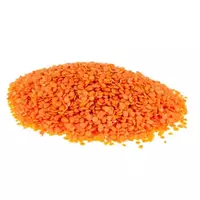Lentils red

Lentils or Lens is a herbaceous plant from the legume family. The genus of lentil plants includes several varieties that grow in the Mediterranean region, as well as Transcaucasia, Central and Asia Minor. Common or cultural lentils are eaten. The plant is part of the group of leguminous crops and is important for food, and in addition, feed significance for the whole of mankind as a whole.
The homeland of lentils is considered to be southern Europe, and besides western Asia, where the plant began to be cultivated during the Neolithic (9, 500 years ago). It is worth noting that the mention of lentils was discovered in the Old Testament, the oldest sacred book of Christians, which dates from the 13th to the 1st century BC. There are several varieties or subspecies of lentils that differ from each other in color.
They distinguish between brown, green, as well as red lentils. The most odious of them can be considered red lentils, since it was from this variety of plant that the famous biblical chowder was brewed. In many countries, red lentils are considered not only a nutritious food, but also a symbol of prosperity. It is for this reason that red lentils are usually served at the festive table.
People began to use the special taste and nutritional properties of red lentils millennia ago. Therefore, in the modern world culinary tradition, there is simply a colossal number of various recipes for cooking red lentils. The properties of red lentils make it possible to reduce the cooking time of the product.
Since unlike green or brown lentils, the variety is red and boils in just 15 minutes. The calorie content of red lentils can vary depending on a number of factors. However, the average calorie content of red lentils is 313 Kcal, which are per 100 grams of product. Lentils are red, not only highly nutritious, but also a healthy food.
Benefits of red lentils
The benefits of red lentils lie in the composition of the plant. As a result of scientific research, it was found that the composition of red lentils contains almost all the necessary compounds for the normal life of a person. The benefit of red lentils lies in the content of a large amount of easily digestible protein of natural origin.
In addition, red lentils include amino acids, vitamins of group A, B, as well as PP and E. You should also not forget about such macro- and microelements that are contained in the chemical composition of red lentils as potassium, sodium, phosphorus, magnesium, calcium, as well as manganese, iron, fluorine, zinc, molybdenum, iodine, cobalt and others. In cooking, red lentils took their rightful place.
Lentils are used to make soups, side dishes, as well as salads and snacks. Red lentils are especially popular in Indian national cuisine. The world-famous Indian dish dal or dhal is essentially a puree soup made with lentils, as well as other legumes, such as black beans, chickpeas or mung beans.
lentils red 313.87 kCal
The energy value of lentils is red (Ratio of proteins, fats, carbohydrates - ju):
Proteins: 21.55 g (~ 86 kCal)
Fats: 1.09 (~ 10 kCal)
Carbohydrates: 48.04 g (~ 192 kCal)
Energy ratio (bj | y): 27% | 3% | 61%
 Español
Español Français
Français Português
Português Русский
Русский 简体中文
简体中文 繁體中文
繁體中文 日本語
日本語 한국어
한국어 العربية
العربية Türkçe
Türkçe Қазақ
Қазақ Deutsch
Deutsch Italiano
Italiano Українська
Українська
